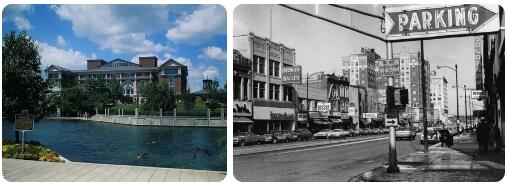Introduction
Indiana (abbr.: IN or Ind.), state of the United States of America, in the Midwest, 93,730 km2, with 5.5 million inhabitants; Capital: Indianapolis. French researchers gave the area the name Indiana around the beginning of the 18th century, after the Indians who lived there. By 1830 all original inhabitants had been expelled or killed.
Physical Geography
Most of Indiana forms a gently undulating prairie area. Northern Indiana belongs to the Great Lakes region. Along the Ohio, which forms the southern border of the state, are hills with sharp ridges and deep valleys; the Ohio Valley is narrow and rocky, but in the southwest it widens and becomes flat. South of Bloomington is a vast limestone area with caves (including the large Wyandotte Cave) and karst phenomena. Indiana has a continental climate with cold winters and warm summers.
Population
The average population density is 59 inhabitants. per km2. About 65% of the population lives in urban areas. The largest cities are Indianapolis, Fort Wayne, Evansville and Gary.
Economy
Despite the great importance of agriculture, Indiana is primarily an industrial state. Mining takes third place. Farmers only make up about 50% of the total rural population and have also often become dependent on secondary income. The most fertile area (loamy) is in central Indiana. This area supplies corn, soybeans, wheat and oats. In northeast Indiana, many tomatoes are grown, in the humid area around the lakes potatoes and onions, in the poorer south fruit, tobacco, vegetables and grains. The livestock includes dairy cattle, pigs and poultry. The mining industry provides coal, petroleum, natural gas and limestone (supplying more than 80% of the need for this building material in the United States). The iron and steel industry in the northwest, especially on Lake Michigan, is one of the most important in the United States. East of Calumet, the major oil companies have their refineries. Also important aerospace (parts), car (parts), electrical and electronics (telecommunications) industries. Musical instruments are manufactured in Elkhart. In Lafayette to aluminum industry and the main producers of prefabricated houses in the United States.
Sights
Major tourist attractions include the motor racing circuit at Indianapolis, the historic town of Vincennes, Lincoln Land (area where Abraham Lincoln spent his childhood), New Harmony, which was the site of an early (1814) community life experiment (restored village), the Spring Mill State Park (restored pioneer village) and the Indiana Dunes National Lakeshore (nature reserve).
History
The main Native American tribe in this area was the Miami tribe, but much earlier the builders of the remarkable prehistoric mounds, many of which can still be found. La Salle explored the country in 1679. In 1763 the area was surrendered to England and in 1787 it became part of the Northwest Territory, which in 1800 was divided into two parts: Indiana and Ohio. A bloody war was waged against the Miami Indians; their chief Little Turtle defeated General Harmar (1790) and General St. Clair (1792), but was defeated by General Anthony Wayne (Battle of Fallen Timbers, 1794). At the Treaty of Greenville (1795) they had to give up a large piece of land. In 1811, Governor WH Harrison defeated Native American chief Tecumseh at Tippecanoe, after which the country was largely open to the whites. In 1816, Indiana was incorporated into the Union as the 19th state. The area was reclaimed by various groups of settlers.
The state had many settlers from the south, but still largely loyally supported the Union in the Civil War. However, there were more appeasementists than in most northern states. Particularly in rural areas, there was much opposition to racial integration, which in the 1920s was expressed, among other things, in racial unrest and the large following of the Ku Klux Klan. Traditionally, the state has been ruled by Republicans; their best-known representative was W. Willkie, Roosevelt’s opponent in 1940.
